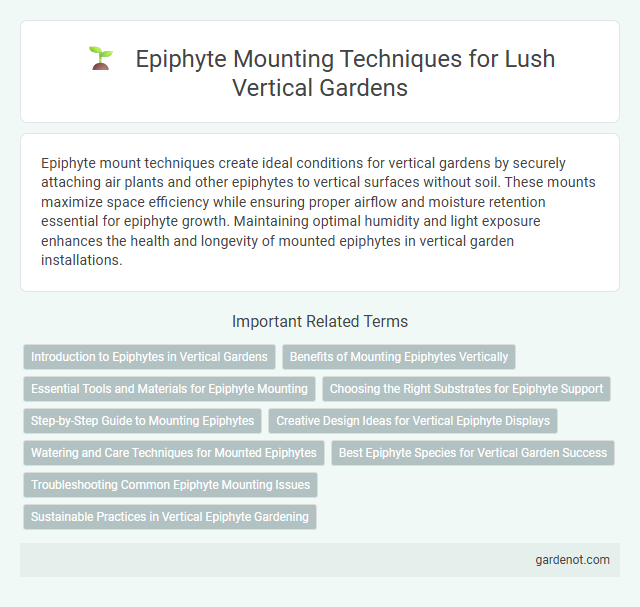Epiphyte mount techniques create ideal conditions for vertical gardens by securely attaching air plants and other epiphytes to vertical surfaces without soil. These mounts maximize space efficiency while ensuring proper airflow and moisture retention essential for epiphyte growth. Maintaining optimal humidity and light exposure enhances the health and longevity of mounted epiphytes in vertical garden installations.
Introduction to Epiphytes in Vertical Gardens
Epiphytes, plants that grow on other plants without harming them, are ideal for vertical gardens due to their unique ability to thrive without soil. Common epiphytes used in vertical gardens include orchids, ferns, and bromeliads, which attach themselves to mounts such as wood, cork, or mesh, mimicking their natural habitat. Their air-root systems absorb moisture and nutrients from the environment, making them efficient, low-maintenance choices for vertical garden installations.
Benefits of Mounting Epiphytes Vertically
Mounting epiphytes vertically maximizes space efficiency by allowing plants to grow naturally on vertical surfaces, ideal for indoor and outdoor environments with limited horizontal area. This method enhances air circulation around the roots, reducing the risk of rot and promoting healthier growth. Vertical mounting also improves aesthetic appeal by creating dynamic, living walls that support biodiversity and contribute to better indoor air quality.
Essential Tools and Materials for Epiphyte Mounting
Essential tools for mounting epiphytes include mounting boards made of cork or untreated wood, sphagnum moss for moisture retention, and soft fishing line or nylon thread for securing plants without damaging roots. Scissors and a spray bottle for misting are necessary to trim excess moss and maintain humidity during the establishment period. Selecting breathable materials ensures proper aeration, crucial for the health and growth of epiphytes in vertical gardens.
Choosing the Right Substrates for Epiphyte Support
Selecting the right substrates for epiphyte mounts is essential to ensure proper moisture retention and airflow, promoting healthy root growth. Common substrates include sphagnum moss, cork bark, and tree fern fiber, each offering varying levels of durability and water-holding capacity. Opt for lightweight, porous materials that mimic natural growing conditions to provide stability while preventing root rot in vertical garden installations.
Step-by-Step Guide to Mounting Epiphytes
Start by selecting healthy epiphyte plants such as orchids or air plants and gather mounting materials like wood plaques, sphagnum moss, and fishing line. Secure a moist layer of sphagnum moss to the wood mount and gently attach the plant's roots using fishing line, ensuring it's firm but not restrictive to promote growth. Place the mounted epiphyte in a location with appropriate humidity and indirect light, mist regularly to maintain moisture, and monitor root attachment over several weeks for successful establishment.
Creative Design Ideas for Vertical Epiphyte Displays
Epiphyte mounts revolutionize vertical garden design by providing innovative ways to showcase air plants, orchids, and bromeliads without soil. Creative design ideas include using driftwood, reclaimed wood panels, or metal grids as naturalistic and sustainable backdrops that enhance plant visibility and airflow. Integrating LED grow lights and moisture-retentive moss complements these mounts, ensuring vibrant, healthy displays in indoor or shaded environments.
Watering and Care Techniques for Mounted Epiphytes
Mounted epiphytes require careful watering techniques to mimic their natural habitat, typically involving frequent misting or soaking to maintain moisture without waterlogging the roots. Using distilled or rainwater helps prevent mineral buildup that can harm delicate tissues, while ensuring adequate air circulation prevents fungal infections and promotes healthy growth. Regular inspections for root hydration and trimming of dead material optimize the health and longevity of mounted epiphytes in vertical gardens.
Best Epiphyte Species for Vertical Garden Success
Orchids, Tillandsia (air plants), and Bromeliads are the best epiphyte species for vertical garden success due to their low maintenance and adaptability to mounted surfaces. These epiphytes thrive in well-ventilated environments with indirect light and require minimal soil, making them ideal for vertical garden installations. Selecting species like Phalaenopsis orchids or Tillandsia ionantha ensures vibrant growth and long-lasting displays on epiphyte mounts.
Troubleshooting Common Epiphyte Mounting Issues
Epiphyte mounts often encounter issues such as poor attachment, inadequate humidity retention, and mold growth due to insufficient airflow. Ensuring the mount material is breathable and positioning the epiphyte to receive indirect light helps prevent rot and promotes healthy root anchorage. Regular inspection and adjusting water spray frequency address dehydration or overwatering problems effectively.
Sustainable Practices in Vertical Epiphyte Gardening
Epiphyte mounts in vertical gardens exemplify sustainable practices by minimizing soil use and conserving water through natural air moisture absorption. These mounts often utilize biodegradable materials such as cork bark or reclaimed wood, reducing environmental impact and promoting eco-friendly gardening. Integrating vertical epiphyte displays enhances urban green spaces while supporting biodiversity and resource-efficient plant care.
Epiphyte mount Infographic

 gardenot.com
gardenot.com